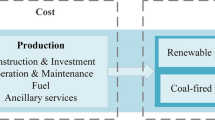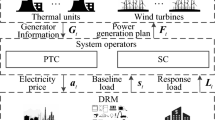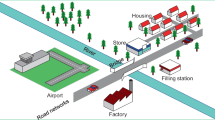Abstract
This paper proposes a real options approach to generation capacity expansion in imperfectly competitive power markets. Our framework incorporates firms with different levels of market power; heterogeneous technologies, including renewables, base load and peak load; time-varying short-term demand and renewable supply; and long-term demand uncertainty. A real options model allows us to obtain technology-specific thresholds for demand to trigger investment. We apply our model to the German power market and show that a doubling of current demand triggers renewable investment, whereas base load generation requires over 50 times current demand on average. The availability of peak load generation serves to avoid rationing and reduce fluctuations in the electricity price. In the absence of incentive mechanisms, however, demand does not become sufficiently high to trigger investment in this technology. We investigate at which level capacity payments to peak power plants prevent rationing without reducing investments in renewables. Furthermore, by accounting for market power, we illustrate that strategic firms do not increase their market shares over time but hold back investment until market prices are sufficiently high for price-taking firms to expand capacity. As a result, the intensity of competition increases over time.






Similar content being viewed by others
References
Agora Energiewende: Sandbag: The European power sector in 2017. State of affairs and review of current
Andresen, T., Parkin, B.: Closing the Book on Nuclear Power Isn’t Easy: QuickTake Q&A. Bloomberg (2016). https://www.bloomberg.com/news/articles/2016-10-03/closing-the-book-on-nuclear-power-isn-t-easy-quicktake-q-a. Accessed 2 May 2017
Baldursson, F.M., Karatzas, I.: Irreversible investment and industry equilibrium. Financ. Stoch. 1(1), 69–89 (1996)
Baldursson, F.M.: Irreversible investment under uncertainty in oligopoly. J. Econ. Dyn. Control 22, 627–644 (1998)
Baringo, L., Conejo, A.: Correlated wind-power production and electric load scenarios for investment decisions. Appl. Energy 101, 475–482 (2013) (sustainable development of energy, water and environment systems)
Batlle, C., Prez-Arriaga, I.J.: Design criteria for implementing a capacity mechanism in deregulated electricity markets. Util. Policy 16(3), 184–193 (2008)
Boomsma, T.K., Meade, N., Fleten, S.E.: Renewable energy investments under different support schemes: A real options approach. Eur. J. Oper. Res. 220(1), 225–237 (2012)
Cramton, P., Ockenfels, A.: Economics and design of capacity markets for the power sector. Zeitschrift für Energiewirtschaft 36(2), 113–134 (2012)
Dixit, A.: Entry and exit decisions under uncertainty. J. Polit. Econ. 97(3), 620–638 (1989)
Dixit, A.K., Pindyck, R.S.: Investment Under Uncertainty. Princeton University Press, Princeton (1994)
Egerer, J., Schill, W.P.: Power system transformation toward renewables: Investment scenarios for Germany. Discussion Paper 1402, German Institute for Economic Research (2014)
EnBW: Power generation. https://www.enbw.com/company/press/download-centre/power-generation/index_en.html. Accessed 21 Feb 2017
ENTSO-E: Load consumption data for Germany. https://www.entsoe.eu/data/data-portal/consumption/Pages/default.aspx. Accessed 21 Feb 2017
Fernandes, B., Cunha, J., Ferreira, P.: The use of real options approach in energy sector investments. Renew. Sustain. Energy Rev. 15(9), 4491–4497 (2011)
Finon, D., Pignon, V.: Electricity and long-term capacity adequacy: The quest for regulatory mechanism compatible with electricity market. Util. Policy 16(3), 143–158 (2008)
Fleten, S.E., Maribu, K., Wangensteen, I.: Optimal investment strategies in decentralized renewable power generation under uncertainty. Energy 55(1), 113–137 (2007)
Fraunhofer ISE: Electricity generation in Germany in 2017. Accessed 21 Feb 2017. https://www.energy-charts.de/energy_pie.ht
Fraunhofer ISE: Net installed electricity generation capacity in Germany, Accessed 21 Feb 2017. https://www.energy-charts.de/power_inst.htm
Gabriel, S.A., Conejo, A.J., Fuller, D., Hobbs, B.F.C.R.: Complementarity modelling in energy markets. Springer, New York (2012)
Gahungu, J., Smeers, Y.: A real options model for electricity capacity expansion. European University Institute Working Papers, EUI RSCAS (2012)
Greenblatt, J.B., Succar, S., Denkenberger, D.C., Williams, R.H., Socolow, R.H.: Baseload wind energy: Modeling the competition between gas turbines and compressed air energy storage for supplemental generation. Energy Policy 35(3), 1474–1492 (2007)
Growitsch, C., Malischek, R., Nick, S., Wetzel, H.: The Costs of Power Interruptions in Germany—an Assessment in the Light of the Energiewende. Working Paper 13/07, Institute of Energy Economics at the University of Cologne (EWI), Köln (2013)
Gurobi Optimization, Inc.: Gurobi optimizer reference manual (2016). http://www.gurobi.com. Accessed 21 Feb 2017
Hach, D., Spinler, S.: Capacity payment impact on gas-fired generation investments under rising renewable feed-in—a real options analysis. Energy Econ. 53, 270–280 (2016)
He, H., Pindyck, R.S.: Investment in flexible production capacity. J. Econ. Dyn. Control 16, 575–599 (1992)
Henriot, A., Glachant, J.M.: Melting-pots and salad bowls: The current debate on electricity market design for integration of intermittent RES. Util. Policy 27, 57–64 (2013)
von Hirschhausen, C.: The German “Energiewende”: An introduction. Econ. Energy Environ. Policy 3(2), 1–12 (2014)
Hirth, L., Ueckerdt, F., Edenhofer, O.: Why wind is not coal: On the economics of electricity generation. Energy J. 37(3), 1–27 (2016)
Hobbs, B.: Linear complementarity models of Nash-Cournot competition in bilateral and POOLCO power markets. In: IEEE Transactions on Power Systems, vol. 16(2) (2001)
Hobbs, B.F., Pang, J.: Nash-Cournot equilibria in electric power markets with piecewise linear demand functions and joint constraints. Oper. Res. 55(1), 113–127 (2007)
Hobbs, B.F., Rijkers, F.A.M., Wals, A.F.: Strategic generation with conjectured transmission prince responses in a mixed transmission pricing system–part II: Application. IEEE Trans. Power Syst. 19(2), 872–879 (2004)
IEA: Projected costs of generating electricity 2015 (2015). https://www.oecd-nea.org/ndd/pubs/2015/7057-proj-costs-electricity-2015.pdf. Accessed 21 Feb 2017
IEA and Nordic Energy Research: Nordic energy technology perspectives 2016 (2016). http://www.nordicenergy.org/wp-content/uploads/2016/04/Nordic-Energy-Technology-Perspectives-2016.pdf. Accessed 21 Feb 2017
Janssen, M., Wobben, M.: Electricity pricing and market power–evidence from Germany. Euro. Trans. Electr. Power 19, 591–611 (2009)
Jing-Yuan, W.F., Smeers, Y.: Spatial oligopolistic electricity models with Cournot generators and regulated emission prices. Oper. Res. 47(1), 102–112 (1999)
Just, S., Weber, C.: Strategic behavior in the German balancing energy mechanism: Incentives, evidence, costs and solutions. J. Reg. Econ. 48, 218–243 (2015)
Karan, M.B., Kazdağli, H.: The development of energy markets in Europe. In: A. Dorsman, W. Westerman, M.B. Karan, Ö. Arslan (eds.) Financial Aspects in Energy: A European Perspective, chap. 2, pp. 11–32. Springer, Berlin (2011)
Kitasei, S.: Powering the Low-Carbon Economy: The Once and Future Roles of Renewable Energy and Natural Gas. Worldwatch Institute, Washington, D.C. (2010)
Knopf, B., Pahle, M., Kondziella, H., Joas, F., Edenhofer, O., Bruckner, T.: Germany’s nuclear phase-out: sensitivities and impacts on electricity prices and $\text{ CO }_2$ emissions. Econ. Energy Environ. Policy 3(1), 89–105 (2014)
Kumbarolu, G., Madlener, R., Demirel, M.: A real options evaluation model for the diffusion prospects of new renewable power generation technologies. Energy Econ. 30(4), 1882–1908 (2008)
Lang, C.: Rise in German wholesale electricity prices: Fundamental factors, exercise of market power, or both? IWE Working Paper No 02/06 (2006)
Lise, W., Hobbs, B.F., Hers, S.: Market power in the European electricity market—the impacts of dry weather and additional transmission capacity. Energy Policy 36(4), 1331–1343 (2008)
Lohmann, T., Rebennack, S.: Tailored Benders decomposition for a long-term power expansion model with short-term demand response. Manag. Sci. 63(6), 2027–2048 (2017)
Lucia, J.J., Schwartz, E.S.: Electricity prices and power derivatives: Evidence from the Nordic power exchange. Rev. Deriv. Res. 5(1), 5–50 (2002)
MATLAB: The MathWorks Inc., Natick, Massachusetts, United States (2016a)
McDonald, R., Siegel, D.: The value of waiting to invest. Q. J. Econ. 101(4), 707–727 (1986)
Montel, Oslo, Norway. https://www.montel.no/. Accessed 21 Feb 2017
de Moraes Marreco, J., Carpio, L.G.T.: Flexibility valuation in the Brazilian power system: A real options approach. Energy Policy 34(18), 3749–3756 (2006)
Morris, C., Pehnt, M.: The German Energiewende Book. Heinrich Böll Foundation, Berlin (2016)
Müsgens, F.: Quantifying market power in the German wholesale electricity market using a dynamic multi-regional dispatch model. J. Indus. Econ. 54(4), 471–498 (2006)
Open Power System Data: Conventional power plants in Germany. http://data.open-power-system-data.org/conventional_power_plants/. Accessed 20 May 2017
Pfenninger, S., Staffell, I.: Long-term patterns of European PV output using 30 years of validated hourly reanalysis and satellite data. Energy 114, 1251–1265 (2016)
Pindyck, R.: Irreversible investment, capacity choice, and the value of the firm. Am. Econ. Rev. 78(5), 969–985 (1988)
Pindyck, R.S.: The dynamics of commodity spot and futures markets: A primer. Energy J. 22(3), 1–29 (2001)
RAP: Report on the German power system. Tech. rep. (2015). Version 1.0. Study commissioned by Agora Energiewende
Reed, S.: Germany strikes offshore wind deals, subsidy not included. The New York Times (2017). https://www.nytimes.com/2017/04/14/business/energy-environment/offshore-wind-subsidy-dong-energy.html. Accessed 22 May 2017
RWE Generation: Power plants in Germany. http://www.rwe.com/web/cms/en/1756472/rwe-generation-se/fuels/location-overview/germany/. Accessed 21 Feb 2017
Sarkar, S.: On the investment-uncertainty relationship in a real options model. J. Econ. Dyn. Control 24(2), 219–225 (2000)
Schröder, A., Kunz, F., Meiss, J., Mendelevitch, R., von Hirschhausen, C.: Current and prospective costs of electricity generation until 2050. Data Documentation 68, DIW Berlin, German Institute for Economic Research (2013)
Schwartz, E., Smith, J.E.: Short-term variations and long-term dynamics in commodity prices. Manag. Sci. 46(7), 893–911 (2000)
Seljom, P., Tomasgard, A.: The impact of policy actions and future energy prices on the cost-optimal development of the energy system in Norway and Sweden. Energy Policy 106, 85–102 (2017)
Sensfuß, F., Ragwitz, M., Genoese, M.: The merit-order effect: a detailed analysis of the price effect of renewable electricity generation on spot market prices in Germany. Energy Policy 36(8), 3076–3084 (2008)
Staffell, I., Pfenninger, S.: Using bias-corrected reanalysis to simulate current and future wind power output. Energy 114, 1224–1239 (2016)
Tangerås, T., Mauritzen, J.: Real-time versus day-ahead market power in a hydro-based electricity market. J. Ind. Econ. (2018) (forthcoming)
Uniper: Power plants in Germany. https://www.eon.com/content/dam/eon-com/Investoren/cmd/Uniper_Equity_Story_Appendix.pdf/. Accessed 21 Feb 2017
Vattenfall: Vattenfall’s power plants. http://powerplants.vattenfall.com/#/view=map/sort=name. Accessed 21 Feb 2017
Weigt, H., von Hirschhausen, C.: Price formation and market power in the German wholesale electricity market in 2006. Energy Policy 36, 4227–4234 (2008)
Wogrin, S., Centeno, E., Barquin, J.: Generation capacity expansion in liberalized electricity markets: A stochastic MPEC approach. IEEE Trans. Power Syst. 26(4), 2526–2532 (2011)
Zhu, L., Fan, Y.: A real options-based CCS investment evaluation model: Case study of China’s power generation sector. Appl. Energy 88(12), 4320–4333 (2011)
Author information
Authors and Affiliations
Corresponding author
Additional information
Publisher's Note
Springer Nature remains neutral with regard to jurisdictional claims in published maps and institutional affiliations.
Appendices
Appendix A: Welfare gain
The welfare gain equals the expected discounted social welfare from the capacity expansions over an infinite time horizon, i.e.
where
is the instantaneous social welfare, i.e. the sum of producer profits and consumer surplus, and \(\{K_{t,f}:t\ge 0\}\) is the (approximate) optimal solution to (35).
Appendix B: Input parameters of the illustrative example
See Table 5.
Appendix C: Input data case study Germany
All costs are given for the years 2017, 2020, 2030 and 2040. We use linear interpolation to determined costs between these years. After 2040, we assume all costs to be fixed at 2040 levels. Validation of data is outside the scope of this paper. See Table 9
See Tables 10, 11, 12, 13, 14, 15, 16, 17, 18.
Appendix D: Determining the level of capacity payment
In implementing capacity payments, the reliability of supply is a major concern. Thus, we argue that capacity payments should be determined such that the level of installed peak load capacity, i.e. gas-fired power plant capacity, approximates the capacity found in Sect. 5.1. Table 19 presents the installed capacity of gas-fired power plants, the share of renewables in 2040, the aggregated rationing from 2017 to 2040 found in section 5.1 and the first paragraph of Section 5.3, i.e. when no capacity policies are implemented. Table 20 shows the effect of different capacity payment levels. We do not examine capacity payments above 31 000 €/MW, as these make OCGT power plants profitable even with sporadic operation.
Table 20 shows that capacity payments for all types of gas-fired power plants result in high investments in gas-fired power plants at the expense of renewables. Moreover, we find that a capacity payment of 31 000 €/MW to OCGT power plants results in a small level of rationing and an installed capacity of gas-fired power plants close to that of the base case that includes minimization of rationing. We therefore argue for capacity payments of 31 000 €/MW to OCGT power plants.
Rights and permissions
About this article
Cite this article
Brøndbo, H.K., Storebø, A., Boomsma, T.K. et al. A real options approach to generation capacity expansion in imperfectly competitive power markets. Energy Syst 11, 515–550 (2020). https://doi.org/10.1007/s12667-019-00325-3
Received:
Accepted:
Published:
Issue Date:
DOI: https://doi.org/10.1007/s12667-019-00325-3




